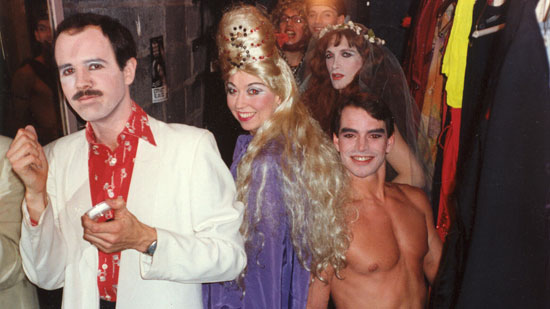|
|
|

1980s East Village, New York
Excerpts from Downtown by Michael Musto, Vintage Books, 1986:
“The downtown scene is so transient that just as you discover a club, you find it’s been turned in a pizzeria, but that’s okay; wait fifteen minutes and it’ll be a club again. There’s such a need for constant stimulation that hair salons have art on the walls and the art galleries can have hair on the walls if they like it. Clubs become showrooms, American Legion offices become clubs, and the only thing certain is that nothing is certain. Roller discos suddenly change into gay Arab-biker sushi bars just for the sake of change, and no one questions the transformation as long as free drink tickets are still available.” (p. 2)
“The fascination may go both north and south, but the thrill of downtown is still the newest and most exciting of recent New York phenomena. A lot more people want to get in than get out. ‘Right now the entire world is focused on downtown,’ says Vito Bruno. ‘It’s a major force. You put those key downtown names on an invitation and everybody wants to come down and check it out.’” (p. 9)

Backstage of Vampire Lesbians of Sodom at the Limbo Lounge, 1984. Left to right: Kenneth Elliott, Julie Halston, Charles Busch, Robert Carey. Back: Tom Aulino, Arnie Kolodner.
“The nicest of the downtown antiheroes, and the least likely to throw up on stage (it’s not aesthetically appealing; besides, he’d want to turn it into a production number) is Charles Busch, a drag performer whose shows at the Limbo Lounge brought him the kind of adoring audience that only stopped laughing so they could hear the next line. There was cause for their devotion; Busch’s extreme likeability, even—or especially—when he’s being vicious, his economy of words and movement, and his total extravagance of wigs and costumes made him both the king and queen of undiscovered New York theater. Busch, like [Ethyl] Eichelberger, plays the great diva roles—in his case, Theodora—She-Bitch of Byzantium, 1940s nightclub chanteuse Irish O’Flanagan (in Times Square Angel), stage actress Madeleine Astarté (in Vampire Lesbians of Sodom) and Gidget. Like John Kelly, his act only begins the second he’s in drag. ‘The dress gives me a lot more confidence,’ he says, ‘I couldn’t even raise my hand in class, but when I have the dress and makeup on, I’m not myself. I’m this actress.’” (p.137)
As a result of their Limbo triumphs, the troupe moved to a very respectable off-Broadway theater, the Provincetown Playhouse, where they received rave reviews and played for a whole new audience who didn’t have to crawl through rubble to discover Busch’s glittering talents. The amazing media approval of Busch, even from the straightest of old fogies, made him into an acceptable adventure for everyone, many of whom found themselves snickering into their three-piece-suit collars for the first twenty minutes before letting go with shameless out-and-out hysteria that said they were happy to be part of Busch’s breakthrough. The word spread, and soon the diva was negotiating a movie deal (West Coast Productions of the Vampire Lesbians/Sleeping Beauty double bill), and no doubt bigger dressing rooms. Busch might even get to Broadway some day (maybe Tuesday). But somehow no matter what happens, his Limbo Lounge days will go down in theater legend as his truly glamorous ones. (p. 138)
|